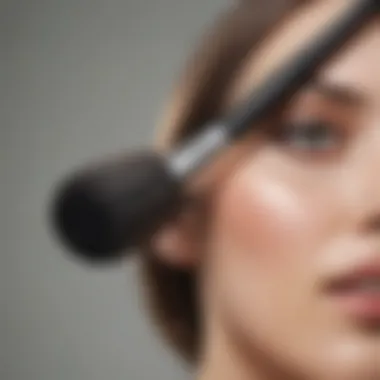Mastering Makeup Brushes: Care and Application Tips


Intro
Makeup brushes are more than just tools lying around in a makeup bag. They are essential players in the dance of beauty, deserving a little more attention than they often get. Think of brushes as the instruments of an orchestra, where each has its unique part to play in creating that harmonious look. But with so many types, sizes, and materials out there, navigating the world of makeup brushes can feel like wading through a dense fog.
This article aims to brighten that fog by shining a light on how to understand and manage these beauty essentials. We’ll touch on the different varieties of makeup brushes available, their specific purposes, and the science behind proper cleaning and storage. Additionally, we’ll discuss why quality matters, revealing how brushes can affect the end result of your makeup application. While we delve into brush maintenance tips to keep your tools in top shape, we won’t shy away from the broader implications of using these tools in personal grooming.
From students eager to learn the ropes to professionals already in the game, this guide is crafted for anyone who wants to truly understand their makeup brushes and elevate their application skills. So grab your favorite brush, and let's get started on this enlightening journey into the world of makeup brushes.
The Role of Makeup Brushes in Beauty Routine
Makeup brushes may seem like just simple tools at first glance, but their significance in a beauty routine runs far deeper. They serve as the intermediaries between the skin and the products designed to enhance one’s natural features. Understanding the essential role these brushes play can dramatically shift how one approaches their makeup application process.
Benefits of Using Makeup Brushes
There are several compelling benefits to incorporating high-quality brushes into a makeup regimen. For one, brushes allow for a more even distribution of product, which means that your foundation or eyeshadow can glide on smoothly without the streaky or clumpy finish that fingers or sponges sometimes leave behind. Moreover, the various brush types cater to different applications, showcasing their versatility—this ensures that individuals can achieve a flawless look tailored to their unique features.
In addition, using brushes can enhance hygiene in makeup application. Brushes limit the transfer of oils and dirt from fingers directly onto the skin, thus reducing the chances of breakouts or irritation. This can be especially important for those with sensitive skin or specific skin concerns such as acne.
Considerations About Makeup Brushes
When integrating brushes into one's beauty routine, consider the quality and material of the brush. Brushes made from natural fibers, like squirrel or goat hair, often provide a softer application, but they may not hold up as well when it comes to keeping out of the water. Conversely, synthetic brushes are typically more durable and easier to clean, making them a pragmatic choice for daily use.
Furthermore, understanding the purpose behind each brush type enhances the overall makeup experience. Knowing when to pull out a tapered brush versus a flat one for foundation can delineate between an
amateur look and a polished finish.
When brushes are used effectively, they allow one to blend products into the skin seamlessly, creating that much sought-after natural effect. In the world of makeup, the difference between a good look and a great look can rest upon the quality and technique of brush usage.
Choosing the Right Brushes for Your Needs
Choosing the right makeup brushes is fundamental to achieving the desired outcome in your beauty routine. Each brush type serves a distinct purpose, and selecting the right tools can make a world of difference. Brushes are not just instruments; they are extensions of your artistry. With the right brush, you can blend like a pro or achieve that airbrushed finish you've long desired.
Considerations for choosing the right brushes involve understanding your own makeup habits, skin type, and desired look. Are you a fan of a natural, radiant finish or do you prefer a more matte look? The choice of brush can help enhance these preferences. Beyond aesthetics, there are practical elements to consider—such as durability, ease of cleaning, and comfort during use. Investing time to choose the right brushes pays dividends in the quality of makeup application.
Synthetic vs. Natural Brushes
When it comes to the material of makeup brushes, two primary categories dominate the market: synthetic and natural. Each type has its unique advantages and disadvantages that appeal to different users.
Synthetic Brushes: These are typically made from man-made fibers, such as nylon or polyester. They offer several benefits:
- Durability: Synthetic brushes tend to withstand wear and tear better than natural ones.
- Vegan-Friendly: Ideal for those who prioritize ethical consumption.
- Water-Resistant: Great for liquid products like foundations or creams as they don’t absorb as much product—this can help achieve a more flawless finish.
Conversely, synthetic brushes might not pick up certain powders as effectively as natural brushes, resulting in a less soft application for some users.
Natural Brushes: Often crafted from animal hair, like sable, goat, or pony, natural brushes provide a different feel. Here are a few points to consider:
- Softness: They tend to be softer, offering a luxurious touch against the skin.
- Pigment Transfer: Natural fibers can hold powder pigments better, which can give a more 'blended' appearance in certain situations.
- Versatility: Many makeup artists prefer natural brushes for products like eyeshadow or blush, as they often provide a more nuanced application.
Despite these advantages, natural brushes require more maintenance and can be more expensive. They’re often recommended for professionals who need high performance but might put off casual users who just want something practical.
"Choosing the right brush goes hand in hand with your makeup goals; know what you want, and choose wisely."
When making your choice, consider your specific needs and preferences. It may be worth trying out both types to see what feels right in your hands and on your skin.
Understanding Brush Shapes and Sizes
Brush shapes and sizes play a critical role in determining how effectively and efficiently you can apply your makeup. Choosing the wrong brush for the job can lead to a frustrating experience and less-than-ideal results.
- Flat Brushes: Commonly used for applying foundation, these brushes offer a smooth and even application. They can also work well for packing eyeshadow onto the eyelid.
- Angled Brushes: These are perfect for creating defined lines, making them great for eyeliner or contouring. The angled shape allows for precision in hard-to-reach areas.
- Round Brushes: Often used for blending, round brushes are a favorite among makeup artists for their ability to soften harsh lines and seamlessly blend colors together.
- Fan Brushes: Typically employed for highlight applications, fan brushes can create a soft, diffused glow on the high points of the face.


Choosing the right shape for your brushes not only improves your application technique but also enhances the overall pigmentation and finish of your makeup. Varying sizes provide versatility—larger brushes for expansive areas of the face, smaller brushes for detail work.
Investing in a variety of brush shapes and sizes tailored to your routine is smart. This enables you to achieve both bold looks and subtle enhancements, ensuring that you have the right tool at hand for any occasion.
Techniques for Effective Brush Application
Proper application techniques significantly influence the overall look and finish of makeup. By mastering certain application methods, one can dramatically enhance the aesthetic outcome, ensuring that makeup not only looks professional but also lasts throughout the day. Getting familiar with techniques like dabbing versus swiping and effective blending strategies can make a world of difference.
Dabbing vs. Swiping Motion
When it comes to applying products like foundation or concealer, choosing between dabbing and swiping can be pivotal.
Dabbing entails a gentle tapping of the brush against the skin, which helps to push the product into the pores. This technique allows for a more natural, skin-like finish. It is particularly handy when dealing with creamier formulas as it minimizes the risk of stripping away any underlying layers of makeup. Using this approach makes it easier to build coverage without feeling heavy on the skin.
On the other hand, swiping involves a more linear motion across the skin. This method can be beneficial for achieving smooth, even coverage in a shorter time, especially when applying liquid foundations. However, it is essential to use this motion carefully, as excessive swiping can disturb previously applied products and lead to an uneven finish.
Ultimately, the choice between dabbing and swiping can hinge on the makeup being used and the desired finish. Below are a few pointers:
- Choose dabbing for:
- Choose swiping for:
- Full coverage looks.
- Cream or liquid formulas.
- Reducing product visibility on the skin.
- Quick application for lighter looks.
- Liquid foundations that glide easily.
- Creating a luminous finish.
Blending Techniques for Flawless Finish
Blending is arguably one of the most critical steps in makeup application. Without it, even the best products may end up looking patchy or overly made up. The goal of blending is to create seamless transitions between colors, ensuring that no harsh lines are visible on the skin.
There are several effective blending techniques to employ depending on the area being worked on:
- Circular Motions: This approach works wonders for powdered blushes or bronzers on the cheeks. By moving the brush in circular motions, it blends the products beautifully, resulting in an airbrushed finish.
- Feathering Motion: For eyeshadow application, a feathering technique can help achieve a soft gradient effect. This usually means lightly dragging the brush tip across the skin, allowing for a beautiful diffusion of color.
- Back-and-Forth Wipe: A technique that mimics windshield wipers, this works best for contouring. Gently dragging the brush along the contour area blends harsh lines into your skin, creating depth without seeming over-done.
To help with blending:
- Ensure brushes are clean; dirty brushes can add unwanted colors.
- Use light pressure; heavy-handedness can ruin work.
- Check lighting; always blend in natural light to see how it looks under normal conditions.
"In the world of makeup, blending is the secret sauce that ties everything together. It’s the difference between looking polished and looking like a work in progress."
By honing in on these techniques, makeup enthusiasts can elevate their application skills, ensuring that the final result not only enhances their features but also reflects an understanding of the artistry involved in makeup application.
Cleanliness and Maintenance of Brushes
Ensuring that your makeup brushes are clean and well-maintained is not just a matter of aesthetics; it plays a crucial role in the performance of your makeup application. Brushes that are neglected can lead to a host of problems including uneven application, clogged pores, and unwanted breakouts. On top of that, cleanliness is key in extending the lifespan of your brushes.
Regular cleaning and proper maintenance are fundamental to keeping both your skin and your makeup in prime condition. Brushes gather oils, dirt, and makeup residue; if not kept clean, they become breeding grounds for bacteria. Thus, integrating a consistent cleaning routine can greatly enhance your beauty regimen.
Importance of Brush Hygiene
The concept of brush hygiene may seem straightforward, yet it holds numerous benefits. Brushes act as tools that apply makeup directly onto the skin. If these tools aren't clean, a few undesirable outcomes can arise:
- Bacteria buildup: The last thing anyone wants is to introduce bacteria into their makeup routine. Using dirty brushes can cause skin irritations or even infections.
- Makeup performance: A dutiable brush yields better results than a dirty one. Your eyeshadow may appear muddled, or foundation can end up looking patchy if it’s applied with brushes that haven’t been properly cleaned.
- Longevity of brushes: Regular cleaning not only promotes hygiene but also ensures that the brushes remain in good shape. Accumulated makeup can cause bristles to fray or lose their shape.
Ultimately, maintaining brush cleanliness should be a non-negotiable aspect of anyone’s makeup routine. Keeping them in prime condition is a small step that leads to a much larger impact on both skin health and the efficiency of your makeup application.
Cleaning Techniques and Solutions
When it comes to cleaning your brushes, there are mainly two techniques to consider: daily and deep cleaning. Both serve unique purposes and result in a healthier and more efficient makeup application.
Daily Cleaning
Daily cleaning of brushes is about quick maintenance to make sure that your brushes are ready for use at a moment's notice. A simple rinse and swipe can work wonders in removing leftover residue of makeup or oils from your face.
The beauty of daily cleaning is in its convenience. You can use a gentle brush cleaner or even a DIY solution made from distilled water and a drop of dish soap. It’s fast and helps maintain your brush’s performance without the labor of a deep clean every day.
Advantages of Daily Cleaning:


- Time-efficient: Takes only a few minutes, making it suitable for busy lifestyles.
- Improves makeup application: Ensures brushes perform optimally for your next makeup session.
However, a potential downside is that it doesn't replace the need for deep cleaning. Daily routines will keep your brushes usable in the short term but won’t address the buildup that can accumulate over months.
Deep Cleaning Techniques
Deep cleaning techniques delve deeper, quite literally, into your brush's health. It's the more thorough method meant to combat any stubborn makeup particles, oils, and grime that daily cleaning may have missed. The practice usually involves soaking the brushes in soapy water or using specific brush cleaners that unlock the buildup effectively.
Deep cleaning should not be overlooked, especially if you use your brushes heavily. This technique can reinstate the freshness of your tools, almost like a spa day for your brushes.
Unique Feature of Deep Cleaning:
- Thorough removal of residues: Ensures that every last trace of makeup is cleared away, significantly reducing the risk of skin irritations.
- Boosted brush longevity: Properly maintained brushes can last years longer than their poorly cared-for counterparts.
While it necessitates more time, set aside for it once a month or as often as your makeup usage demands.
In sum, understanding and implementing these cleaning techniques enhance both the application results and the lifespan of your makeup brushes, ensuring that you are not just investing in quality but maintaining that investment effectively.
Storage Solutions for Makeup Brushes
The way you store your makeup brushes can significantly influence not just their longevity but also the quality of your makeup application. Brushes are delicate tools; they deserve thoughtful care and an appropriate environment when not in use. Proper storage solutions can help prevent damage to bristles, keep them from becoming contaminated, and ensure they remain in peak condition for your next makeup routine.
When brushes are haphazardly stored, it’s akin to a painter leaving their tools strewn about. Just like paintbrushes, makeup brushes can become bent, misshapen, or dirty, leading to a subpar application if not handled properly. Moreover, an organized storage system contributes immensely to efficiency.
Best Practices for Storing Brushes
Keeping your brushes tidy extends their life and keeps your makeup area looking immaculate. Here are some recommended practices for effective storage:
- Use a Brush Holder: Many designers advocate for proper brush holders that stand upright. This technique keeps bristles from getting crushed and maintains their original shape. Try glass jars, cup holders or even specialized brush organizers.
- Avoid Direct Sunlight: Prolonged exposure to sunlight can degrade bristles over time. Choose a cool, dark place for your brushes away from windows
- Store Separately: Never mix your brushes with other beauty tools or products. Each brush should have its designated space to prevent cross-contamination and to keep hygienic.
- Clean Regularly: Maintain cleanliness of your storage containers. Dust or other impurities can transfer to your brushes, leading to poor makeup effects.
"Keep your brushes in line, and they'll keep you looking fine!"
By treating your brushes like the valuable tools they are, you’ll notice a substantial difference in performance and longevity.
Travel Considerations and Brush Protection
When it comes to travels, makeup enthusiasts know that a good brush protection plan is essential. Whether jet-setting overseas or heading to a local gig, protecting your brushes is just as important as packing your makeup. Here are some key strategies:
- Invest in a Brush Roll or Case: These cases are specifically designed to protect brushes from damage while letting them breathe. They can feature compartments so that brushes don’t rub against each other, which helps maintain their shape.
- Use a Protective Sleeve: For short trips, a protective sleeve can be a quick solution. These sleeves can usually accommodate one or two brushes and protect the bristles when stuffed in a bag.
- Seal with Plastic: If you’re really in a pinch, wrap your brushes in plastic to keep them safe from any potential damage until you reach your destination.
- Avoid Packing Brushes on Their Side: Laying brushes flat can mess up the bristles. Stand them up whenever possible during transport.
With proper storage solutions, your brushes will not only survive the travel but remain effective tools in your beauty arsenal. Taking the time to think through how and where you keep your brushes pays off with a seamless makeup application and maintained tool integrity.
The Impact of Brush Quality on Makeup Application
When it comes to makeup application, the tools you use can be as vital as the products themselves. The quality of brush you choose not only influences the ease of application but also affects the overall outcome and durability of your look. High-quality brushes can make or break your makeup experience, lending precision, blending power, and longevity to your routine.
Understanding Brush Materials
Brush materials come in two main categories: synthetic and natural. Each type brings its own set of advantages to the table, making it essential to understand their characteristics before settling on the right brushes for your makeup arsenal.
Synthetic Brushes
Synthetic brushes, crafted from materials like nylon or polyester, are increasingly popular in the beauty industry. They offer several benefits, such as:
- Cruelty-Free Options: Being made from synthetic fibers, they are often favored by those who take an ethical stance against animal testing.
- Less Absorbent: They tend not to soak up products as much as natural brushes do, making them ideal for cream and liquid formulations. This means you get maximum product on your face, rather than trapped in the brush.
- Durability: They often withstand frequent washings better, making them last longer, especially if you're committed to regular cleaning routines.
Natural Brushes
Conversely, natural brushes, made from animal hair, have unique advantages:


- Softness & Blending: They tend to be softer and can blend products more seamlessly, especially powders, giving a more airbrushed effect on skin.
- Versatility: Different types of animal hairs provide different textures and applications. For instance, squirrel hair is very soft, great for blending, while goat hair has a coarser texture, excellent for picking up powder pigments.
Knowing whether to invest in synthetic or natural brushes often boils down to personal preference and application techniques.
Price Points and Value in Brushes
Price isn’t always indicative of quality, but it does often reflect the materials and craftsmanship involved in brush-making. For those serious about their makeup game, understanding where to invest is key.
Entry-Level Brushes
There are many budget-friendly options available. These brushes can serve well for beginners or for those just experimenting with different makeup styles, including:
- Basic Synthetic Sets: Often found at drugstores, they provide decent quality at an affordable price.
- General Purpose Brushes: A foundation brush or a basic eyeshadow brush can be found for less than ten dollars without breaking the bank.
Mid-Range and High-End Brushes
As makeup applications become more intricate, investing in quality brushes becomes paramount:
- Performance: Mid-range brushes ($20-$50) typically offer a significant upgrade in both materials and performance. They often blend better and can last longer with proper care.
- Luxury Brushes: High-end brushes ($50 and above) often represent the apex of craftsmanship and may incorporate rare materials or advanced design techniques. These brushes not only enhance the makeup experience but can often serve as a long-term investment.
Ultimately, it’s about balance: investing wisely in a few quality pieces generally yields better results than buying a whole collection of inexpensive ones. As the old saying goes, **
Environmental Considerations in Brush Manufacturing
In the quest for beauty, a lot often gets overlooked, particularly the environmental impact tied to makeup tools like brushes. With increasing awareness around sustainability, the focus on how makeup brushes are made is rising. It's not just about how well they perform or how you apply your makeup, but also about what goes into creating them and the ultimate footprint they leave on our planet. This topic fits seamlessly into a comprehensive exploration of makeup brushes, as understanding their environmental aspects helps users make informed choices that are beneficial not just for themselves but for the Earth too.
The production of makeup brushes typically involves various materials—many of which have significant environmental footprints. From the sourcing of natural hairs to the production of synthetic fibers, each step carries implications for ecology and sustainability. For example, natural hair brushes often come from animals, raising questions regarding ethical sourcing. Brands must consider how these materials impact biodiversity and animal welfare. Conversely, synthetic brushes, while cruelty-free, rely heavily on plastic materials that contribute to pollution and waste.
Addressing this dilemma involves not just assessing individual products, but also understanding the entire brush manufacturing process to identify environmentally-friendly practices. Encouraging the use of sustainable materials is one piece of the puzzle. However, ongoing engagement and responsibility from consumers play an equally crucial role.
"A brush can be a tool of beauty, but it can also be a signal of our commitment to the planet."
Sustainable Materials in Brush Production
The call for sustainable materials in brush production isn't just a trend; it signals a shift toward more responsible manufacturing practices in the beauty industry. Natural materials, like bamboo handles and recycled aluminum ferrules, offer excellent alternatives to traditional brushes that otherwise use non-biodegradable plastics.
- Bamboo: This fast-growing plant is an eco-friendly option. It absorbs carbon dioxide at a high rate and can be harvested without killing the plant. Bamboo handles provide durability, lightweight convenience, and a natural aesthetic that many users find appealing.
- Recycled Materials: Using recycled fibers for brush hairs or handles aids in reducing waste. Brands focused on sustainability are now producing brushes made entirely from recycled plastic, which dramatically cuts down on what ends up in landfills.
- Vegan Synthetic Fibers: Technological advancements in synthetic materials create brushes that mimic the softness and effectiveness of natural hairs without the ethical concerns. These fibers can be designed to reduce waste in their production process as well.
By opting for brushes made from these materials, consumers can minimize their environmental impact while still enjoying a high standard of beauty. However, it’s essential to examine certifications and transparency from brands to ensure that sustainable claims hold water.
Consumer Responsibility in Makeup Choices
At the end of the day, consumers wield a hefty influence over manufacturing practices through their purchasing decisions. Understanding the environmental implications of makeup brushes can significantly shift market dynamics, pushing brands toward more sustainable options. As consumers, it’s not just about convenience or price; making informed choices helps drive progress in the industry.
- Research Brands: Examine and support brands that prioritize sustainability. Look for transparency in production processes and materials used. If a brand claims to be eco-friendly, a little digging goes a long way.
- Invest in Quality Over Quantity: Higher quality brushes that last longer are a sounder investment than cheaper, less durable options that end up as waste more quickly. It’s about seeing the value in longevity.
- Practice Responsible Disposal: When brushes reach the end of their life cycle, explore how to dispose of or recycle them responsibly. Some manufacturers offer take-back programs to encourage recycling.
Embracing responsibility in makeup choices means taking a stand. By demanding more sustainable options and embracing eco-friendly practices, we're not just enhancing our beauty routines; we're putting our money where our values are and supporting a more sustainable future.
The Future of Makeup Brushes
As makeup trends continue to evolve, so too does the technology and design behind makeup brushes. The future of makeup brushes is not just about aesthetics; it's about the functional advancements that can enhance application techniques, improve user experience, and promote sustainability. Innovations in texture, material, and ease of use are becoming ever more crucial for users who want to achieve a flawless finish while also being conscious about their environmental impact. Understanding these upcoming changes can enable consumers and professionals alike to make informed choices about their tools.
Innovative Designs and Technologies
Recent years have seen a shift toward innovative designs in makeup brushes. Manufacturers are no longer content with traditional shapes and sizes. One notable trend is the rise of multifunctional brushes, which can serve multiple purposes while maintaining their effectiveness. For instance, consider brushes that have dual-ended designs, combining the properties of blending and precision within one tool. This not only saves space in one's makeup kit but also enhances convenience during application, making it perfect for those who are always on-the-go.
Furthermore, advancements in materials are shaping the future of brush manufacturing. Brushes made with synthetic fibers have come a long way, simulating the feel and application of natural bristles while ensuring cruelty-free production. The introduction of antibacterial materials in brush fibers is another interesting development; this feature can help prevent skin irritation and ensure better hygiene for users.
"Innovative brush designs can make the difference between a mediocre look and an absolutely striking finish."
The Evolution of Makeup Application Tools
Makeup brushes have a rich history, constantly evolving with the times. Looking ahead, we can anticipate a continued shift that emphasizes not only functionality but also user education. With the rise of social media platforms, learning how to use these tools properly has never been more accessible. Influencers and professionals alike share their techniques and tips, which encourages a greater understanding of how different brushes perform in various scenarios.
This educational element will likely shape the design of future brushes as well. Tools may become integrated with technology, such as smart brushes with sensors that provide feedback on technique or application pressure. Imagine a brush that connects to an app, giving tips on the pressure you're applying, or suggesting which brush is best suited for a particular makeup product. Such tech-driven solutions could bridge the gap for users who may feel overwhelmed by the sheer selection of brushes available.



